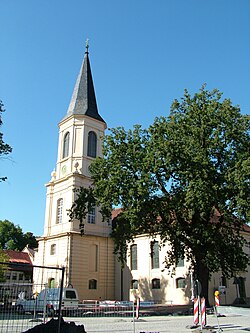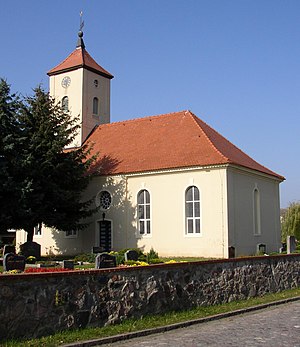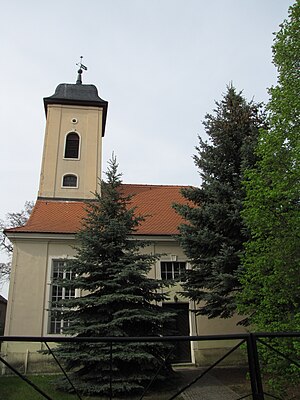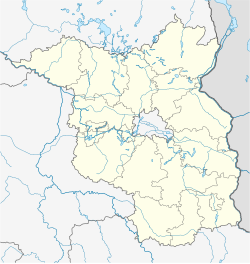Zossen
Zossen | |
|---|---|
 Church of the Holy Trinity | |
Location of Zossen within Teltow-Fläming district <imagemap>File: Zossen in TF.png | 240x240px poly 157 149 165 143 157 136 161 118 162 99 154 96 176 97 201 103 201 113 189 115 193 127 205 140 191 144 185 150 178 155 Am Mellensee poly 165 212 192 205 214 211 230 194 261 187 254 174 260 166 239 154 223 149 219 152 204 141 189 143 187 154 171 161 191 165 192 190 170 192 158 197 Baruth/Mark poly 183 58 174 55 169 48 168 31 179 39 180 30 178 12 180 12 198 21 205 34 214 34 212 43 200 44 Blankenfelde-Mahlow poly 184 276 181 245 184 232 160 240 151 221 159 209 161 207 171 214 182 206 192 206 190 227 200 228 196 248 205 246 226 253 233 257 223 277 231 281 212 288 Dahme poly 227 253 235 243 232 236 229 232 206 226 198 230 193 247 209 244 Dahmetal poly 141 45 155 35 176 44 179 33 179 7 169 0 150 26 140 30 Großbeeren poly 187 281 183 236 168 237 171 254 161 264 159 274 Ihlow poly 107 211 88 208 74 201 79 186 64 177 59 153 76 148 98 153 104 156 124 184 134 200 123 213 Jüterbog poly 128 179 129 169 131 158 127 139 116 144 108 133 105 129 96 140 98 156 110 159 123 180 Luckenwalde poly 154 70 133 68 128 66 122 80 110 71 111 66 112 55 122 50 116 44 118 42 140 38 141 47 150 38 163 39 169 41 185 61 172 76 154 79 Ludwigsfelde poly 153 271 173 249 167 236 155 232 149 220 158 207 141 201 132 202 125 213 109 214 106 217 96 224 110 233 93 239 94 253 115 250 114 259 118 244 139 254 134 264 136 279 155 280 Niederer Fläming poly 96 254 94 240 111 237 102 226 103 216 69 202 75 188 41 174 29 184 18 197 3 202 2 208 11 214 27 204 27 227 42 228 55 222 68 241 84 241 77 250 Niedergörsdorf poly 153 202 132 196 125 177 128 139 117 141 103 131 92 140 99 160 71 152 55 124 89 103 121 102 125 117 136 110 130 123 143 122 149 115 165 105 160 142 154 151 172 153 181 169 189 164 189 188 174 189 157 197 Nuthe-Urstromtal poly 224 65 208 57 216 51 218 47 199 39 181 55 193 71 206 72 Rangsdorf poly 147 123 151 112 163 106 157 80 151 66 131 68 121 76 112 75 99 85 93 107 118 98 123 99 127 119 134 112 132 120 Trebbin poly 229 149 228 101 236 103 223 74 204 82 203 79 183 61 174 75 154 75 155 96 177 96 199 99 206 111 188 116 205 140 212 153 Zossen poly 0 85 0 0 87 0 88 86 Brandenburg desc bottom-right </imagemap> | |
| Coordinates: 52°13′00″N 13°26′59″E / 52.21667°N 13.44972°E | |
| Country | Germany |
| State | Brandenburg |
| District | Teltow-Fläming |
| Subdivisions | 7 Orts- und 9 Gemeindeteile |
| Government | |
| • Mayor (2019–27) | Wiebke Schwarzweller[1] (FDP) |
| Area | |
| • Total | 179.57 km2 (69.33 sq mi) |
| Elevation | 38 m (125 ft) |
| Population (2022-12-31)[2] | |
| • Total | 21,433 |
| • Density | 120/km2 (310/sq mi) |
| Time zone | UTC+01:00 (CET) |
| • Summer (DST) | UTC+02:00 (CEST) |
| Postal codes | 15806 |
| Dialling codes | 03377 |
| Vehicle registration | TF |
| Website | www.zossen.de |

Zossen (German pronunciation: [ˈt͡sɔsn̩] ; Upper Sorbian: Sosny, pronounced [ˈsɔsnɨ]) is a German town in the district of Teltow-Fläming in Brandenburg, about 30 kilometres (20 mi) south of Berlin, and next to the B96 highway. Zossen consists of several smaller municipalities, which were grouped together in 2003 to form the city.
Geography
Since the 2003 municipal reform, Zossen consists of the following districts and municipalities:
|
|
History
Zossen, like most places in Brandenburg, was originally a Slavic settlement. Its name (Upper Sorbian: Sosny) may derive from Sosna meaning pine, a tree quite common in the region.
In 1875, Zossen railway station opened on the railway line from Berlin to Dresden and the Prussian military railway to the artillery range at Kummersdorf-Gut in present-day Am Mellensee. Between 1901 and 1904, Zossen adopted the use of different high-speed vehicles, such as electric locomotives and trams, for transportation to and from Berlin-Marienfelde. These vehicles were powered by an alternating current of 15 kV and used a variable frequency. The power was transmitted by three vertical overhead lines.
In 1910, a proving ground and a garrison of the Imperial German Army was established at the Waldstadt section of the Wünsdorf community – surviving to the present day. In World War I it was the site of several prisoner-of-war camps, including the "crescent camp" (Halbmondlager for Muslims who had fought for the Triple Entente), where the first wooden mosque in Germany was erected. The camp ran from 1915 until 1917, and was used as a show camp for propaganda purposes, as well as an attempt to encourage the prisoners to fight for the Central Powers. Named after the structure, the adjacent Mosque Street (Moscheestraße) has kept its name to this day.[3][4]
From 1939 to 1945, Wünsdorf hosted the underground headquarters of the German Wehrmacht (OKW) and Army's High Command (OKH).
After World War II the area became the site of a Soviet military camp in East Germany known as "Little Moscow" or the "Forbidden City", the largest outside Russia, housing as many as 75,000 Soviet men, women and children with daily trains going to Moscow,[5] until Soviet troops pulled out in August 1994. Since then it has returned to civilian use as the Wünsdorf-Waldstadt book town (founded in 1998),[6] although much of it lies abandoned with evidence of Soviet occupation clearly visible.[7] By late 2019, roughly 1,700 apartments were made from the old barracks, with another 700 planned for subsequent years.
A 2017 news report indicates that at the peak, the camp was home to some 75,000 Soviet persons; stores, schools and leisure centres were available to them. After the camp was abandoned, the authorities found "98,300 rounds of ammunition, 47,000 pieces of ordnance, 29.3 tonnes of munitions and rubbish, including chemicals ... houses were full of domestic appliances".[8]
While new uses have not been found for the installations and bunkers of the unmodified areas of the military camp,[7] they are somewhat maintained and there are various guided tours, exhibits and events.[6] Some parts remain off-limits.[5][9][10]


Timeline
- 1809/1810: Kietz and the vineyards of Zossen are suburbanised
- 1885: Monument to the fallen soldiers of the 1864, 1866, and 1870 wars is erected in Kietz
- 1906: School on Kirchplatz is expanded
- 1910: Military area between Zossen and Wünsdorf is developed
- 1932: Flyers of the town councillor and deacon Emil Phillip regarding the threatening change in the Protestant community and the city Zossen
- 1933: As a result of the National Socialists' rise to power, Socialists and Communists in Zossen are arrested by SS troops and are held in the school on Kirchplatz. Emil Phillip is removed from his post, upon the order of Pastor Eckerts
- 1934: Expansion of the town hall
- 1939: The military zone in Zossen is developed into military headquarters
- 1956: The city park is created
- 1992: The "Alter Krug" Zossen society is founded
- 1994: Formation of the administrative district of Teltow-Fläming from the old districts of Jüterbog, Luckenwalde, and Zossen
- 1996: 450th anniversary of Prince Elector Joachim II's awarding of rights and privileges to Zossen
- 1998: Wünsdorf Book Town declared, the only book town in Germany[6] – though Mühlbeck-Friedersdorf, which started in 1997, claims to be the first book town in Germany.[11]
Demography
-
Population since 1875 within the current borders (blue line: population; dotted line: normalized population of Brandenburg; grey background: time of Nazi rule; red background: time of communist rule)
-
Population 2005–2018 (blue lines) and projections to 2030 (dotted lines) from 2005 (yellow line), 2017 (velvet line) and 2020 (green line), including census in 2011
|
|
|
Mayors
- Hans-Jürgen Lüders (SPD) 1993–2003
- Michaela Schreiber: 2003-2019
- Wiebke Schwarzweller: since 2019
Notable people

- Karl Friedrich August Lehmann (1843–1893), stenographer and inventor of the Stenotachygraphie shorthand system
- Frieda Kassen (1895–1970), politician (SPD)
- Walter Budeus (1902–1944), Communist and resistance fighter
- Roy Präger (born 1971), football player
See also
References
- ^ "Wiebke Schwarzweller ist neue Bürgermeisterin von Zossen". MAZ - Märkische Allgemeine (in Deutsch). Retrieved 2020-02-25.
- ^ "Bevölkerungsentwicklung und Bevölkerungsstandim Land Brandenburg Dezember 2022" (PDF). Amt für Statistik Berlin-Brandenburg (in German). June 2023.
{{cite web}}: CS1 maint: unrecognized language (link) - ^ Andrews, TL; Osinski, Agathe (20 April 2017). "How Germany used Islam during World War I". Al Jazeera. Retrieved 12 December 2023.
- ^ Gith, Thomas (27 October 2015). "Wünsdorf - Deutschlands älteste Moschee stand mitten im Wald" [Germany's oldest mosque stood in the middle of the forest]. Deutschlandfunk Kultur (in Deutsch). Retrieved 12 December 2023.
- ^ 5.0 5.1 "The Forbidden City: inside the abandoned Soviet camp of Wünsdorf", The Guardian, Ciarán Fahey, 11 January 2017
- ^ 6.0 6.1 6.2 "Welcome ⋆ Bücher- und Bunkerstadt Wünsdorf". Bücherstadt-Tourismus GmbH, Wünsdorf-Waldstadt. Retrieved October 12, 2019.
- ^ 7.0 7.1 Rosenberg, Steve (October 8, 2019). "Inside the Soviet base the Cold War left behind (4:43)". BBC News. Retrieved October 12, 2019.
- ^ The Forbidden City: inside the abandoned Soviet camp of Wünsdorf
- ^ "This abandoned 'Forbidden City' was once the largest Soviet military base in East Germany". CNN Travel
- ^ "Contact & Getting There". buecherstadt.com
- ^ "Mühlbeck-Friedersdorf – das erste deutsche Buchdorf | My CMS".
- ^ Detailed data sources are to be found in the Wikimedia Commons.Population Projection Brandenburg at Wikimedia Commons
External links
- Zossen Home page — in German only
- CS1 Deutsch-language sources (de)
- CS1 maint: unrecognized language
- Short description with empty Wikidata description
- Coordinates not on Wikidata
- Towns in Brandenburg
- Pages with German IPA
- Articles containing Upper Sorbian-language text
- Pages using Lang-xx templates
- Pages with Upper Sorbian IPA
- Articles containing German-language text
- Commons category link is the pagename
- Localities in Teltow-Fläming
- Teltow (region)
- Military facilities of the Soviet Union in Germany





